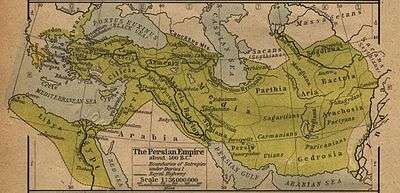Lydia (satrapy)
Lydia, known as Sparda in Old Persian, was a satrapy (province) of the First Persian Empire, with Sardis as its capital. Tabalus, appointed by Cyrus the Great was the first satrap (governor), however, his rule did not last long as the Lydians revolted. The insurrection was suppressed by general Mazares and his successor Harpagus. After Cyrus' death, Oroetus was appointed as satrap. Oroetus ruled during the reign of Cambyses and after the chaotic period after the Persian king's death, he conquered the Greek isle of Samos, killing its ruler Polycrates. Due to his growing power, Darius the Great had Bagaeus kill Oroetus. Bagaeus himself may have become satrap for a short period, but the next rulers were Otanes and Darius' younger brother, Artaphernes.
During the Ionian revolt in 499 BC, Sardis was sacked by the Greeks. Five years later, the rebellion was suppressed and to the surprise of the Greek world, Artaphernes was very lenient in his treatment of the rebels.
After this period, many Persians settled in Lydia. The worship of eastern gods such as Anahita, as well as persified Lydian deities, began. Although members of the Persian aristocracy were given estates in the region following the Greek revolt, Greeks loyal to the Persian Empire were also given estates.
Artaphernes was succeeded as satrap in 492 BC by his son, also called Artaphernes. From the period of 480 BC to 440 BC, there is little historical information about the satrap of Lydia. In 440 BC, the satrap Pissuthnes attempted to retake Samos, which had rebelled against Athens, but failed. In 420 BC, Pissuthnes revolted against the Persian king Darius II. The Persian soldier and statesman Tissaphernes (Pers. Tiθrafarna, Gr. Τισσαφέρνης) a grandson of Hydarnes, was sent by Darius II to Lydia to arrest and execute Pissuthnes. Tissaphernes became satrap of Lydia in 415 BC and continue to fight Amorges, son of Pissuthnes.
After Sparta had defeated Athens, the Greeks invaded Lydia. Tissaphernes overcame the invasion of Thibron in 399 BC but was defeated at Sardis by the Spartan King Agesilaus II. The satrap was executed and replaced by Tiribazus who restored order in Lydia and was responsible for a series of treaties between the Persian king and the Greek city states.
Autophradates was probably Tiribazus' direct successor, and was loyal to the Achaemenid monarch during a series of revolts in 370 BC. The last satrap of Lydia was Spithridates, who was killed by Alexander the Great at the battle of Granicus.
Satraps
- Tabalus (546–545 BCE)
- Mazares (545–ca. 544 BCE)
- Harpagus (ca. 544–?)
- Oroetus (before 530–ca. 520 BCE)
- Bagaeus (ca. 520–? BCE)
- Otanes (517 BCE)
- Artaphernes I (513–492 BCE)
- Artaphernes II (492–after 480 BCE)
- Pissuthnes (before 440–415 BCE)
- Tissaphernes (ca. 415–408 BCE)
- Cyrus the Younger (408–401 BCE)
- Tissaphernes (400–395 BCE)
- Tiribazus (395–? BCE)
- Autophradates (c.365 BCE)
- Spithridates (?–until 334 BCE)
See also
References
- Lendering, Jona. Lydia — Livius.org (accessed 18 January 2013)
